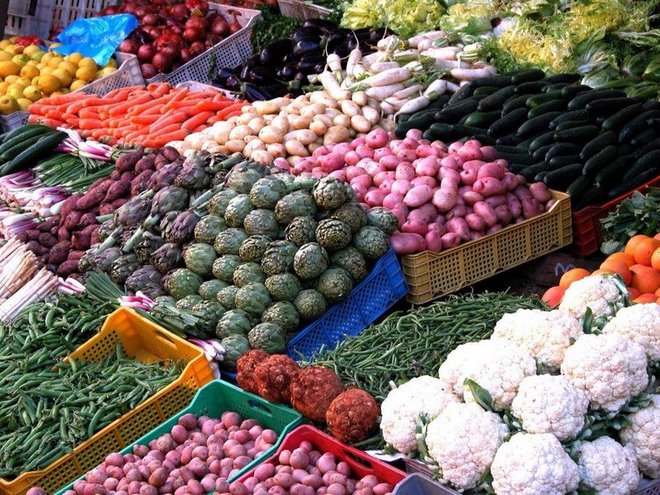Friday, February 23, 2007
Meal Planning: An essential for my success in healthy eating
That changed when I developed medical problems related to food (IC); suddenly, figuring out what to eat if I hadn't planned my meals was a very upsetting prospect, as I was often left with little to eat that wouldn't make me ill. Going out to eat regularly was expensive and still often left me sick. I learned that I had to plan my meals--preferably for each week on the weekends, so that I had time to decide what we wanted and didn't have stuff go bad in the fridge from waiting too long for me to use it.
Even as my medical problems have faded (if you have a bad case of IC, we should talk--my doctor is a miracle worker), I have stuck to planning our meals week by week. I find that planning our meals is important financially to keep us from eating out too often, and it's also important to enable me to balance meals that are higher in calories/fat/sugar with ones that are lower in them. I try to make sure every meal is very high in nutrients from vegetable and fruit content. I almost always pick whole grains, and I put a good source of protein in virtually every meal.
Right now, I am usually planning our meals Wednesday to Tuesday so that I have time to figure out each week what we'll be getting from our CSA's Wednesday deliveries. This week we were very busy, so I'm planning today. (I have today off from work.) While I'm planning, I use Google and allrecipes.com to search for recipes that have the ingredients that I either know I want to use or know I'll have on hand because of the CSA. I also flip through cookbooks, any magazines we have with food, and my fat three-ring binder where I keep copies of recipes I like, divided by season, stored in plastic page covers. For the most part (though this week isn't as good about this as previous ones), I try to keep most of our meals seasonally appropriate.
When I am figuring out what we will eat, I first label my Word page with the days of the week and any days we have things going on that might affect meals. If I know I want to eat out on any particular night (we go out about once a week), I label that night on my sheet. Otherwise, I may leave one night blank so that we can shift the meals around and eat out once that week. (I didn't do that this week because we've eaten out so often lately.)
Then I plan out our meals. Our weeknight meals are usually simple; I try to keep my hands-on time for those meals to 30 minutes or less, though sometimes with baking they may take as long as an hour (or more, on rare occasions). As I choose a meal for a day, I label that day with the meal on my Word doc. If we have weekends like this one where I will not be very busy, I sometimes enjoy making more elaborate meals--like my Saturday night Indian feast this week. As I am planning, I keep up the pages with recipes that I am looking at. Then I print the recipes, make notes on them about any changes I want to make, and, starting from the first day listed on the my Word Doc, I go down the page and type in what ingredients I need to purchase at the store and what recipe those ingredients correspond to. (If the grocery store doesn't have an important ingredient, I want to know what else not to buy to cancel out that recipe.) After I have finished adding ingredients from recipes, I add to the list any items we need to pick up for our regular consumption--almond milk for my husband's breakfasts, for example. I put question marks beside any items that we may already have in the house--I check for those items right before I leave for the store.
As I am typing up my list of ingredients, I separate the list into the parts of the grocery store I vist, in the order I reach them while walking through the store: produce, bulk and nuts, canned/boxed foods, frozen foods, general dairy, refrigerated protein, beer/wine, the cheese counter, most desserts, and then miscellaneous items. (I know that I buy organic and fair-trade whenever possible, so I do not note that on my list unless I'm sending my husband to the store without me!) My process might sound anal retentive to some, but it makes my time in the store more efficient when I'm not wandering back and forth for this ingredient and that one. I cross off each ingredient on my list as I go so that I accidentally do not forget to buy something I need. If I am going to get an ingredient from another store or source, I put a box around that word.
One bonus of shopping with a week's meal plan is that while I might add an item or two while I'm in the store, I keep myself from buying all sorts of impulse purchases when I know that I have a list of foods that will keep us from being hungry over the next few days.
I'm sharing all of this information in such great detail because I find that planning my meals like this keeps me on track. I think it might be important for other people who are watching their food choices (and/or their budget!) as well.
To give you an example of what my final product looks like, this is my meal plan for the week:
Friday--Vegetarian shepherd's pie (Vegetarian Times, p. 11) with a side salad with avocado, Parmesan, and a light dijon dressing
Saturday--(lunch) oatmeal with apples, egg cups; (dinner) dhal with sides of roasted tomatoes, toasted pita bread, raita, and green onion/veggie fritters
Sunday--(lunch) pitas with hummus, raita, cucumber, spinach, onion, and tomatoes and sweet potato fries; (dinner) Spicy Coconut Sweet Potato Soup with Collard Greens with crispy tempeh strips (Fresh Food Fast, p. 230)
Monday--big salad with roasted winter rosemary vegetables (onion, turnip, rutabaga, sweet potato) and pan-fried goat cheese (MAKE DRESSING), refrigerated WF soup
Tuesday (I have AOM)--chickpea salad with lemon and Parmesan; Greek pasta salad with carrots, tomatoes, and cucumber; cold broccoli with garlic--for us to take with us to work (MAKE ON MON)
Wednesday (D. teaches class, I have PL)--leftovers
7 apples (oatmeal and breakfast)
2 pears (snacks)
1 c. cilantro (dhal, soup)
2 lb. tomatoes + 1 (roasting and sandwiches)
1 English cucumber (raita)
1 regular cucumber (pasta salad)
fresh mint (raita)
1 zucchini (fritters)
6 carrots (2 for fritters, 2 for roasted veggies, 2 for pasta salad)
4 yellow onion (shepherd's pie = 1, sandwich + salad = 1, soup = 2)
2 sweet potatoes (shepherd's pie on Friday, before farmer's market)
2 regular potatoes
4 sweet potatoes (sweet potato fries = 2, roasted veggie salad = 1, soup = 1) (F. MARKET)
1 rutabaga (salad)
1 turnip (salad) (F. MARKET)
1 Meyer lemon (salad dressing)
1 lemon (chickpeas)
broccoli (cold broccoli with garlic)
garlic
fresh dill (tzatziki)
1 small jalapeno--subsitute poblano? (soup)
1 small bunch of collard greens (soup)
1 lime (soup)
2 shallots (shepherd's pie)
brown jasmine rice (soup)
1 c. red lentils (dhal)
spiral whole-wheat pasta (pasta salad)
coriander? (soup)
canola oil
vegetarian gravy mix (shepherd's pie)
dijon mustard (salad)
frozen peas and carrots mix
1 c. of Greek yogurt (1/2 c. for raita, 1/2 c. for tzatziki)
goat cheese (salad)
small container milk (shepherd's pie)
hummus (sandwiches)
1 container of ground tofu (shepherd's pie)
2 containers of tempeh strips (soup & tempeh)
pita bread
WF refrigerated soup
Thursday, January 25, 2007
Tacos and . . . soup?
I've been revisiting the idea lately, though, because I love a good salad now, and if you shop at Whole Foods (or similar stores), you can get ready-made, decently low-calorie soups that are really worth eating--like the refrigerated pumpkin soup the store is currently selling that is 110 calories for a cup. Delicious.
In Southwestern food, it is common to serve pumpkin in or alongside dishes that contain corn and black beans, so I've taken to doing the same thing. Pumpkin foods can be made savory, but as mildly sweet foods, they add a nice foil to saltier Southwestern/Tex-Mex fare. Last night, I made veggie tacos (black beans, guacamole, salsa, sprouted cilantro--hey, no cheese!) with pumpkin soup on the side.

With this meal, I was able to enjoy a crunchy, delicious blue-corn taco and a side of tasty, flavorful soup for a moderate calorie count--instead of eating three tacos as I would be tempted to do if they were our only food offering for the evening.
Sunday, January 21, 2007
This week's meals
This is the post I'm writing while I'm procrastinating from going to the grocery store. It's raining, and I hate the end parts of grocery shopping in the rain--unpacking the cart in the rain, and trudging up to our apartment while the bags bead up with water and I get damp and frizzy. Ick. It doesn't look like the rain is easing up, though, so I probably will be out in it in a few moments.
Yesterday at the farmer's market, I purchased these items:
turnips
rutabagas
African squash
kale
rainbow chard
sweet potatoes
peas (some type of heirloom peas similar to field peas)
baby spinach
salad mix
arugula
micro cilantro
. . . and from the bakery, we got a loaf of whole-wheat sourdough for me to test whether sourdough still makes me sick. Oh, that piece of bread was delicious with the soup I had for lunch. A year and a half without sourdough was too long (or maybe just long enough--we'll see).

Given that I can't shake the cold drafts creeping through our house (now that it's actually cold this week, we need to tape the windows), all I want to eat this week is food that is healthy but also warm and comforting. This is our meal plan for the week:
Sunday: winter vegetable pot pie with hummingbird peas and Kentucky biscuit topping
Monday (early dinner by necessity = easy meal): homemade pizza with walnut pesto, pears, and caramelized onions; then a salad with a homemade raspberry dressing (no vinegar, made with frozen raspberries) on top of it
Tuesday: leftovers
Wednesday (another early dinner by necessity = easy meal) : blue corn tacos with black beans, guacamole, salsa, and fresh corn with cilantro; and low-fat pumpkin soup on the side
Thursday: dinner at Margaret's
Friday: African squash/sage mac'n'cheese with a side of garlicky chard
In a surprise move yesterday, my husband--one of the world's sausage lovers--announced to me that he will no longer be eating pork after reading this Rolling Stone article about hog farming. Then he said he might consider organic pork, but would still have reservations about the waste issues. Very interesting and surprising.



